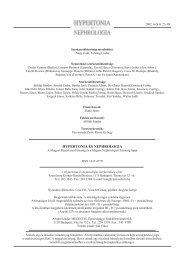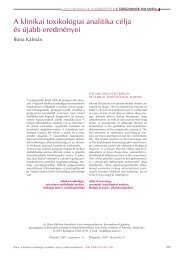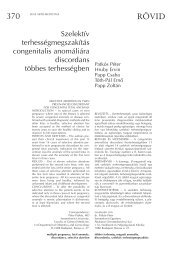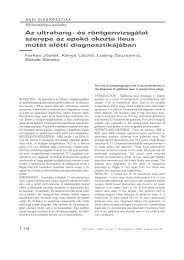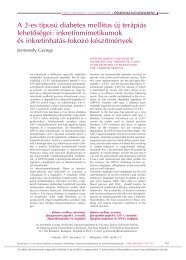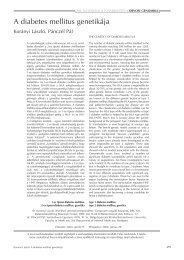HYPERTONIA ÉS NEPHROLOGIA - eLitMed.hu
HYPERTONIA ÉS NEPHROLOGIA - eLitMed.hu
HYPERTONIA ÉS NEPHROLOGIA - eLitMed.hu
Create successful ePaper yourself
Turn your PDF publications into a flip-book with our unique Google optimized e-Paper software.
2002; 6 (1):3–15. ONTOGENY OF POTASSIUM TRANSPORT IN THE DISTAL NEPHRON 13<br />
intercalated cells in CCDs isolated from newborn and adult<br />
rabbits (Fig. 10). The inhibition of the luminal K + -dependent<br />
pHi recovery by micromolar concentrations of<br />
Schering-28080 (15), a relatively specific inhibitor of gastric<br />
H-K-ATPase, led us to conclude that the isoform present on<br />
the apical surface of the PNA-binding intercalated cell was<br />
similar to the „gastric” isoform.<br />
These data alone do not predict that an apical H-K-ATPase<br />
would permit transepithelial K + absorption under physiologic<br />
conditions. Zhou and Wingo (77) showed that CCDs from K +<br />
replete rabbits possessed an apical H-K-ATPase capable of<br />
significant HCO3 - absorption, yet absorptive K + fluxes were<br />
not detected in these segments. The investigators proposed<br />
that this was due to the lack of a basolateral K + conductance<br />
and presence of an apical K + exit pathway in intercalated cells,<br />
thereby allowing K + transported into the cell via the<br />
H-K-ATPase to recycle across the apical membrane. In<br />
contrast, in CCDs isolated from K + restricted animals, an<br />
apical H-K-ATPase in series with a basolateral bariumsensitive<br />
K + channel apparently permits substantial K +<br />
absorption (72; 77). T<strong>hu</strong>s, of critical importance in predicting<br />
the magnitude of the H-K-ATPase-mediated K + absorptive<br />
flux in the neonatal CCD is characterization of the basolateral<br />
K + conductance(s) in the unique cell types.<br />
Also an important determinant of the rate of H-K-ATPasemediated<br />
K + absorption in the collecting duct is the K +<br />
concentration of the tubular fluid delivered to that site. In vivo<br />
measurements of distal tubular fluid K + concentration in the<br />
neonatal rat, estimated from micropuncture experiments, are<br />
approximately twice those reported in the adult (36). A high<br />
tubular fluid K + concentration may facilitate lumen-to-cell K +<br />
absorption mediated by the H-K-ATPase.<br />
SUMMARY The distal nephron of the neonatal kidney,<br />
specifically the CCD, is uniquely suited to retain K + ,asis<br />
appropriate and necessary for growth. Neonatal CCDs<br />
microperfused in vitro show no net K + secretion until after the<br />
third week of life, unlike adult segments, which secrete K + at<br />
high rates. As summarized in this review, the limited K +<br />
secretory capacity of the neonatal CCD appears to be due<br />
primarily to a low K + secretory capacity of principal cells,<br />
which possess few conducting apical stock channels. The<br />
increase in number of conducting SK channels during<br />
postnatal life, reflecting induction of transcription and<br />
translation of ROMK, is likely to promote K + secretion into<br />
the tubular fluid, and thereby contribute to the increase in rate<br />
of urinary K + excretion observed in maturing animals.<br />
Opposing K + secretion in the CCD may be K + absorption, a<br />
process mediated by intercalated cells. Fluorescent functional<br />
assays show that PNA-binding intercalated cells in the<br />
neonatal CCD possess comparable apical H-K-ATPase<br />
activity to that measured in the adult. Under conditions<br />
prevailing in the neonatal nephron (e.g., substantial distal<br />
delivery of K + ), H-K-ATPase-mediated K + absorption may<br />
represent an important route for K + retention.<br />
Studies now underway focus on elucidating the cellular and<br />
molecular mechanisms responsible for the developmental<br />
regulation of K + transport in the distal nephron. The results of<br />
these analyses promise to increase our understanding of the<br />
signals that direct epithelial differentiation and, from a clinical<br />
perspective, provide insight into the pathophysiologic<br />
mechanisms underlying inherited and acquired disorders of<br />
K + homeostasis.<br />
ACKNOWLEDGEMENTS The author thanks the<br />
post-doctoral fellows and students, referenced as appropriate<br />
in themanuscript, who have contributed to this work and Beth<br />
Zavilowitz for her technical support. This workwas supported<br />
by grants from the National Institutes of Health DK38470 and<br />
American Heart Association Grant-in-Aid (LMS).<br />
REFERENCES<br />
1. Giebisch G. Renal potassium transport: mechanisms and<br />
regulation. Am J Physiol 274: F817-33., 1998.<br />
2. Sulyok E, Nemeth M, Tenyi I, Csaba IF, Varga F, Gyory E and<br />
T<strong>hu</strong>rzo V. Relationship between maturity, electrolyte balance<br />
and the function of the renin-angiotensin-aldosterone system in<br />
newborn infants. Biol Neonate 35: 60-5, 1979.<br />
3. Engbretson BG and Stoner LC. Flow-dependent potassium<br />
secretion by rabbit cortical collecting tubule in vitro. Am J<br />
Physiol 253: F896-903, 1987.<br />
4. Grantham JJ, Kurg MB and Orloff J. The nature of transtubular<br />
Na and K transport in isolated rabbit renal collecting tubules. J<br />
Clin Invest 49: 1815-26, 1970.<br />
5. Imai M and Nakamura R. Function of distal convouted and<br />
connecting tubules studied by isolated nephron segments.<br />
Kidney Int 22: 465-472, 1982.<br />
6. Madsen KM and Tisher CC. Structural-functional relationship<br />
along the distal nephron. Am J Physiol 250: F1-15., 1986.<br />
7. Satlin LM. Regulation of potassium transport in the maturing<br />
kidney. Semin Nephrol 19: 155-65, 1999.<br />
8. Good DW and Wright FS. Luminal influences on potassium<br />
secretion: sodium concentration and fluid flow rate. Am J Physiol<br />
236: F192-205, 1979.<br />
9. Malnic G, Klose RM and Giebisch G. Micropuncture study of<br />
distal tubular potassium and sodium transport in rat nephron. Am<br />
J Physiol 211: 529-47, 1966.<br />
10. Satlin LM. Postnatal maturation of potassium transport in rabbit<br />
cortical collecting duct. Am J Physiol 266: F57-65, 1994.<br />
11. Schwartz GJ and Burg MB. Mineralocorticoid effects on cation<br />
transport by cortical collecting tubules in vitro. Am J Physiol<br />
235: F576-85, 1978.<br />
12. Koeppen BM, Biagi BA and Giebisch GH. Intracellular<br />
microelectrode characterization of the rabbit cortical collecting<br />
duct. Am J Physiol 244: F35-47, 1983.<br />
13. Sansom SC and O’Neil RG. Mineralocorticoid regulation of<br />
apical cell membrane Na + and K + transport of the cortical<br />
collecting duct. Am J Physiol 248: F858-68, 1985.<br />
14. Stanton BA, Biemesderfer D, Wade JB and Giebisch G.<br />
Structural and functional study of the rat distal nephron: effects<br />
of potassium adaptation and depletion. Kidney Int 19: 36-48,<br />
1981.<br />
15. Constantinescu A, Silver RB and Satlin LM. H-K-ATPase<br />
activity in PNA-binding intercalated cells of newborn rabbit<br />
cortical collecting duct. Am J Physiol 272: F167-77, 1997.<br />
16. Satlin LM, Matsumoto T and Schwartz GJ. Postnatal maturation<br />
of rabbit renal collecting duct.III. Peanut lectin-binding<br />
intercalated cells. Am J Physiol 262: F199-208, 1992.



